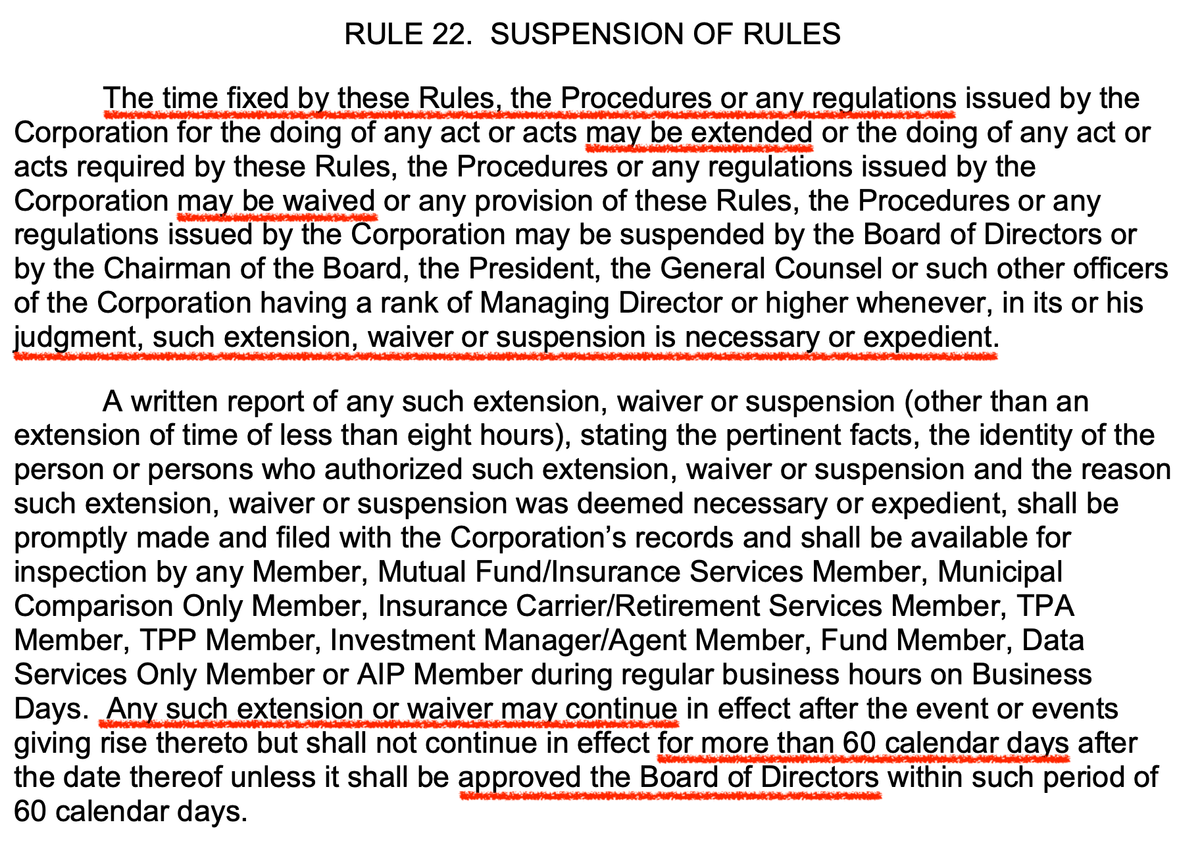Rule Change to FINRA Rule 4210 (Margin Requirements): "the proposed rule is designed to protect FINRA"

"FINRA stated that a given broker-dealer is not protected by the fact that another broker-dealer “up the chain” has already collected margin or taken a capital charge."

Source: https://www.sec.gov/rules/sro/finra/2023/34-98003.pdf
Background:
- Most residential mortgages in the U.S. are pooled and securitized, resulting in mortgage-backed securities that come with credit guarantees from entities like Fannie Mae and Freddie Mac.
- Trading of these securities happens predominantly in the To-Be-Announced (TBA) market, and they clear through the Mortgage-Backed Securities Division.
- Broker-dealers often require collateral, or "margin," when dealing with the purchase and sale of these securities. There are several types of margins, including initial, maintenance, and variation margins.
- The Board of Governors of the Federal Reserve System and self-regulatory organizations (SROs) have set margin rules since the 1930s. Regulation T sets initial margin requirements, and SROs like FINRA set maintenance margins.
- Prior to 2016, FINRA didn’t have specific rules addressing the TBA market. In 2016, they added amendments to their rules, requiring risk determinations and margin collection from counterparties involved in these securities.
- There was a concern that the 2016 amendments favored larger broker-dealers over smaller ones, and to address this, FINRA proposed more rule changes in 2021, intended to reduce burdens especially for smaller broker-dealers. These 2021 amendments made significant changes to the previous 2016 amendments.
- In 2022, the Bond Dealers of America and Brean Capital filed a petition for the Commission to review the 2021 amendments. Their request was to disapprove them, which would keep the 2016 amendments in place.
- After a de novo review, the Commission determined that the 2021 amendments meet the requirements of the Exchange Act and do not impose unnecessary burdens. Therefore, the 2021 amendments were approved, overriding the previous 2016 amendments.
The 2016 Amendments (SR-FINRA-2015-036):
- In 2015, FINRA proposed a rule change to establish margin requirements for Covered Agency Transactions, which involved requiring broker-dealer members to determine credit risk and collect margin for these transactions. This proposal was made public in October 2015, and FINRA extended the review deadline for the proposal to January 2016. Over 100 comment letters were received on this proposal.
- In January 2016, FINRA made amendments to the proposal based on the feedback. The changes, among others, excluded some securities and provided split start dates for the rules: six months for credit risk determinations and eighteen months for margin collections. The Commission then began proceedings to decide whether to approve or disapprove the modified proposal, which extended the decision timeline by 90 days.
- Further amendments were made by FINRA in March and May 2016. Notably, the third amendment increased an exception limit for broker-dealers from $2.5 million to $10 million, meaning they wouldn't need to collect margin from counterparties with $10 million or less in these transactions.
- In June 2016, the Commission announced an accelerated approval of the rule change after three rounds of amendments. The deadline to implement the credit risk determination rule was December 15, 2016, and the margin collection rule's effective date was set for October 25, 2023. No objections were raised against the final version of the rule change.
The 2021 Amendments (SR-FINRA-2021-010):
In May 2021, FINRA proposed a rule change to adjust the margin requirements for Covered Agency Transactions. The changes intended to:
- Remove the two percent maintenance margin requirement for specific accounts.
- Allow members, under certain conditions, to opt for a capital charge rather than collecting margin for excess net mark to market losses.
- Streamline and consolidate the rule language for better clarity.
- The proposed change was opened for public feedback, and by June 30, 2021, the review deadline was pushed to August 23, 2021. Five comment letters were received.
- In August 2021, after considering feedback, FINRA amended the proposal. The changes included redefining “non-margin counterparty,” clarifying the net capital deductions related to unmargined excess net mark to market losses, and establishing a start date for the updated margin collection rules.
- Subsequently, the Commission initiated a review process for the proposal and the amendment. During this time, additional comment letters were received and FINRA provided further responses.
- The amended proposal was approved by the Division on January 20, 2022. However, shortly after, two entities – the BDA and Brean Capital – filed an intent to review the approval. This act halted the enforcement of the rule change. The Commission then opened the floor for more comments and set a timeline for any party to share their stance on the rule change.
- By May 10, 2022, both FINRA and the petitioning entities had submitted their respective arguments regarding the approval order. Additionally, more than ten other statements from the market players were received concerning the review petition.

A. Removal of the Two Percent Maintenance Margin Requirement
Under the existing 2016 Amendments, Rule 4210 has distinct margin requirements for "exempt" and "non-exempt" accounts.
- Non-exempt accounts face stricter requirements. Broker-dealers have to collect a two percent maintenance margin in addition to margin to address the counterparty's mark to market loss. This means broker-dealers must collect margin from non-exempt accounts based on two percent of the contract value of the net position, along with any net mark to market loss, barring specific exceptions.
- In contrast, for exempt accounts, broker-dealers just need to collect margin equal to any net mark to market loss, without needing to collect maintenance margin.
- With the 2021 Amendments, concerns were raised about the different treatments being cumbersome. Determining which accounts are non-exempt requires analyzing and evaluating financial information, which adds complexity.
- Feedback since the 2016 Amendments highlighted that the risks the maintenance margin was designed to mitigate are not significant enough to justify the burdens and competitive disadvantages it causes.
- Notably, this maintenance margin would be applicable to only a few participating entities in the Covered Agency Transaction market. Monitoring and collecting this margin for these few accounts is seen as operationally challenging.
- Additionally, bank dealers don't have to collect maintenance margin from their clients, placing broker-dealers at a competitive disadvantage.
- To address these issues, FINRA has proposed to scrap the distinctions in paragraphs detailing the margin requirements for exempt and non-exempt accounts. They propose a new paragraph that would mandate broker-dealers to collect margin for every counterparty's excess net mark to market loss, except where specified. This means both exempt and non-exempt accounts would be treated equally regarding margin for Covered Agency Transactions.
B. Option for Capital Charge Instead of Mark to Market Margin:
The 2021 Amendments introduce a new paragraph to Rule 4210, allowing broker-dealer members, under certain conditions, to choose a capital charge rather than collecting margin for a counterparty’s net mark to market loss if it exceeds $250,000.
- This change addresses concerns of smaller firms feeling competitively disadvantaged, as larger firms more easily negotiate margining agreements.
- Instead of collecting margin, firms can now deduct the counterparty’s unmargined net mark to market loss from their net capital.
- Restrictions and conditions ensure financial stability, like a member's net capital deductions for all accounts combined not exceeding $25 million. If deductions exceed this for five consecutive days, the member must notify FINRA.
- If deductions surpass the lesser of $30 million or 25% of a member’s tentative net capital for five consecutive business days, restrictions apply to the member’s transactions.
C. Simplification and Consolidation of Rule Language & Conforming Revisions:
FINRA suggests various changes to make the rule language clearer and more cohesive.
- Consolidate terms related to exceptions, like the de minimis transfer amount and $10 million gross open position.
- Removal of now-irrelevant defined terms.
- Modification and merging of language about excepted counterparties and risk limits.
- Textual updates due to the removal of the two percent maintenance margin requirement.
- Changes to supplemental material to align with proposed rule modifications.
- The $250,000 de minimis transfer exception remains intact, but the context around it is streamlined.

Wut mean?:
- The definition of “non-margin counterparty” is changed to exclude small cash counterparties and other exempted entities.
- "Specified net capital deductions" for a FINRA member are defined concerning certain unmargined excess net mark to market losses, with exceptions based on expectations of timely margining.
- Implementation Timeline:
- If the Commission approves this amendment, FINRA will announce its effective date in a Regulatory Notice within 60 days post-approval.


Wut mean?:
- Based on certain conditions, FINRA wants to give broker-dealers the choice to take a capital charge rather than collect excess net mark to market loss exceeding $250,000 from a counterparty.
Support for the Change:
- Some members appreciated the proposal, noting its alignment with other parts of FINRA Rule 4210, which allow capital charges instead of collecting margin for high-credit-quality securities.
Concerns & Opposition:
- Critics believe the proposed capital charge would affect liquidity, especially for smaller broker-dealers. These broker-dealers might not have or be able to obtain margin agreements and would thus be required to take capital charges.
- Certain market participants like pension funds and state agencies could be restricted from pledging assets and hence unable to post margin.
- The limitations could severely restrict FINRA members from introducing liquidity, particularly during volatile periods.
- Smaller broker-dealers might need to maintain a lot of excess net capital to adhere to the new rule, potentially reducing liquidity and affecting regulatory capital during certain market situations.
- This requirement could prevent many smaller broker-dealers (including those owned by minorities, women, and veterans) from participating in Covered Agency Transactions or could limit their business operations.
- Overall, critics argue that the proposal could reduce market liquidity, disrupt the mortgage origination process, and negatively impact various market participants and customers.

FINRA's Response:
Initial Amendments and Adjustments:
Multiple revisions made in the 2016 Amendments to alleviate potential impact on smaller firms:
- The increase of the small cash counterparty exception from $2.5 million to $10 million.
- Creation of an exception for cash investors concerning the two percent maintenance margin requirement.
- Exemption for mortgage bankers, multifamily housing securities, and project loan program securities from new margin requirements.
- Establishment of a $250,000 de minimis transfer amount, allowing members to either not collect margin or take a charge to their net capital.
- FINRA committed to monitoring the impact of these 2016 Amendments and expressed willingness to further adjust if they proved overly burdensome.
Direct Response to Industry Concerns:
FINRA developed rule changes to:
- Eliminate the two percent maintenance margin requirement for certain transactions.
- Allow members to take a capital charge in certain situations instead of collecting margin.
- They believe these changes provide clarity and relief to industry players.
Feedback and Recent Events:
- Despite the changes, some industry commenters have expressed persistent concerns.
- The volatility during the COVID-19 pandemic highlighted the importance of risk management.
- FINRA emphasized the ongoing significance and scale of the Covered Agency Transaction market.
Aim of the 2021 Amendments:
- These were crafted to address concerns, especially for small and medium-sized brokers.
- The idea was to help level the playing field by offering alternatives to collecting margin, ensuring they remain competitive.
- FINRA cited an instance where a petitioner (BDA) had requested the very changes proposed in the 2021 Amendments, highlighting how they're addressing industry concerns.
- Regarding Procedural Concerns:
- FINRA defended its procedures and consultation processes in the development of the 2021 Amendments.
- They emphasized that they weren't obligated to retrace the entire rulemaking process of the 2016 Amendments to make the 2021 changes.
- They also rebutted claims that they failed to disclose consultation details for the 2021 Amendments.
TLDRS:
- FINRA has detailed the process of developing the 2021 Amendments
- The proposed rule change aims to level the competitive field in the Covered Agency Transaction market.
One of the main intentions is to provide smaller FINRA member broker-dealers an alternative to margin collection while ensuring the regulatory goals are met.
- The 25% TNC / $30MM Threshold is in place to encourage margin collection. Allowing firms to take a capital charge instead of margin adds flexibility but doesn’t replace margin requirements.
- FINRA disagrees with some concerns raised, stating that the primary objective is to promote margin collection in the Covered Agency Transaction market. Taking a capital charge in lieu of margin should not replace the primary objective.
- Concerning entities like pension funds and state agencies possibly being unable to post margin, FINRA disagrees. They believe registered investment companies can post margins. Furthermore, under a 2013 Advisory Opinion, ERISA pension plans can post both initial and variation margins.
- The proposed amendment to permit FINRA members to replace margin collection with a capital charge is intended to offer flexibility while preserving the rule's overall efficacy.
- Some comments suggest the proposed change may lead to higher capital or margin charges due to transactions not netting under the proposed change. FINRA clarifies the netting requirements and acknowledges that in some scenarios, the requirements under the proposed rule might be higher. However, the primary objective remains to protect against unsecured credit exposure in Covered Agency Transactions.
- The proposed rule change offers certain advantages over the current rule, such as removing the two percent maintenance margin requirement. This makes the proposed rule more lenient in terms of margin requirements and capital charges than the existing rule.
- FINRA: "it is likely that there would be a “daisy chain failure” regardless of the liquidation requirement because the counterparty would likely be unable to pay or deliver on the Covered Agency Transaction’s settlement date."




Ruh-roh!!!



it is likely that there would be a “daisy chain failure” regardless of the liquidation requirement because the counterparty would likely be unable to pay or deliver on the Covered Agency Transaction’s settlement date.



